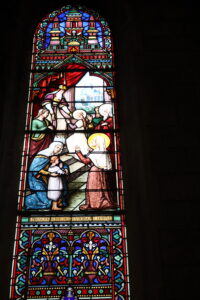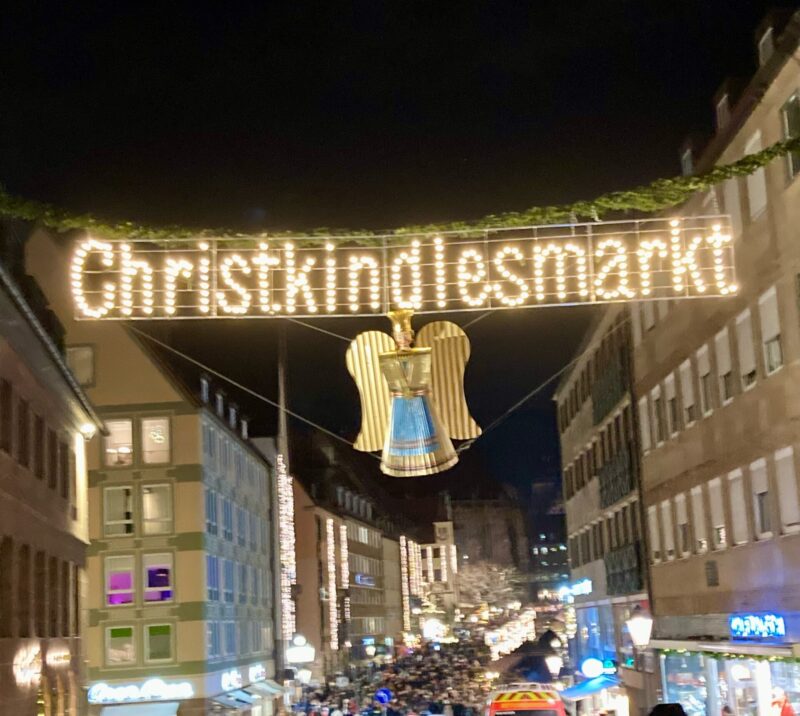My Regensburg Year Part 4: November 2024
Winter has come to Regensburg. Who would have thought it would be so . . . misty? There have been a few flurries but most of the time the sky has been grey and the air heavy with water. Not rain, just . . . wet. Seems like a good time to go somewhere warm.
But first, this past month we took a small trip to nearby Bamberg, a charming town an hour north of Nuremberg. The altstadt in the center has winding streets, plenty of medieval buildings, enough bridges to make you think of Venice (one section is actually called Little Venice), and a picturesque Altes Rathaus that has become the town’s iconic image.

Our major travel destination was France. My wife asked me to suggest somewhere to go to celebrate my birthday. I suggested Marseille because I was interested in visiting some sites related to apocryphal traditions about Mary Magdalene and Martha of Bethany, who are said to have evangelized Marseille and nearby Tarascon. Little did we know when we booked the trip that Marseille has one of the highest crimes rates in France but as it turns out, the sites I wanted to visit are not actually in the city. So we flew to Marseille but stayed in nearby Aix-en-Provence and went from there to Cannes and Nice. In Aix we saw some relics of Mary, Martha, and Lazarus (some very small bones) in the Cathédrale Saint-Sauveur (but no art, alas). Then we departed the city for Saint-Maximim-la-Saint-Baum to see the Basilique Saint-Marie-Madeleine. where there is a cathedral dedicated to Mary Magdalene. Several images of Mary decorate the church (but nothing specifically apocryphal). A crypt contains two sarcophagae—one said to be the resting place of Marcilla, Martha’s maid and writer of the Life of Martha of Bethany—and a relic of Mary’s head. A bit grim, really. The area where Mary spent her last days (according to some traditions) is located 16 km away from the town, but without our own wheels, we were unable to visit it.
So we moved on to Canne and basked in some lovely sunshine. No apocrypha here but who cares? We were there for the weather and it didn’t disappoint. Our day in Nice, however, was gray and damp. And we quickly found that its main attraction for my wife, the Chagall Museum, was closed. Who closes museums on Tuesdays? More importantly, who travels 570 miles to visit a museum and doesn’t check to see if it’s open? Not just us, apparently, as we met some other disappointed travellers at the building’s closed doors. Ah well.

Our final trip of the month was to Nuremberg (for the third time!) to see the Palace of Justice (site of the Nuremberg trials) and the legendary Christmas market. Somewhere in there I squeezed in a comprehensive exams defence for a York student (huddled in one of the libraries, searching desperately for a decent wifi signal) and a visit to the St Lorenzkirche where I finally saw Martha. The church houses a fifteenth-century altarpiece with a series of panel paintings depicting episodes from the Life of Martha of Bethany. Success!
As for work, I put the finishing touches on the final chapter of my Anchor Yale volume on the Christian apocrypha—I said “final chapter” but that doesn’t mean it’s finished; I like to do things out of order. But half the book is done (all the apocryphal acts, martyrdoms, etc.) and I took great satisfaction in printing the chapters off so that I could do some fine editing. Now I have to go back to the first half of the book focusing on Jesus. I started some writing on this section ages ago, so I’m struggling to figure out where I was in my researching and writing. I decided to tackle the infancy gospels chapter first, which should come fairly easy to me given my interests. But the first text I cover in the chapter is the Ascension of Isaiah, which I don’t know that much about.
It might seem odd to start the book off with an Old Testament pseudepigraphon, but it is at least partly Christian-authored and there is good reason to date the text fairly early. The text is separated into two halves: 1–5 is typically called the Martyrdom of Isaiah and details his arrest and death; 6–11 is called the Ascension of Isaiah and tells of his journey to heaven. Scholars differ on how the two halves relate to one another, and whether or not they incorporate earlier Jewish materials, but all are in agreement that the text is the product of a prophetic Christian group writing in the late first or early second century. The portion of most interest here is the Ascension, which describes the descent of the Beloved from the seventh heaven to earth, where he incarnates as the baby Jesus. The birth has some extraordinary features. One day, when Mary and Joseph are alone together, “Mary straightaway beheld with her eyes and saw a small child” and “her womb was found as it was before she was with child” (11:8-9; trans. Müller). A rumor spreads that “she has not given birth: the midwife has not gone up [to her] and we have heard no cries of pain” (11:14). Jesus is presented as not like other infants but acts like one so “that he would not be recognized” (11:17). Similar ideas are found in another Old Testament pseudepigraphon called the Odes of Solomon, an early Christian hymnbook dated to the late first or early second century. Ode 19, preserved only in Syriac, depicts the conception and birth of Jesus as follows:
The womb of the Virgin took [the milk of the two breasts of the Father],
and she received conception and gave birth.
So the Virgin became a mother with great mercies.
And she labored and bore the Son but without pain,
because it did not occur without purpose.
And she did not seek a midwife,
because he caused her to give life. (19.6–9; trans. Charlesworth)
The motifs of laboring without pain and not needing a midwife also appear in a cluster of testimonia about Jesus in the Acts of Peter 24 (as discussed by Norelli 2009:70–78; and Kaestli 2011:519–25). It’s possible that all three writers draw upon a common set of testimonia for their accounts. This is particularly interesting because the canonical Gospel of Matthew also seems to have been constructed on the basis of testimonia, so perhaps we see the continuation of this literary strategy in these noncanonical texts.

Also included in the chapter is the Book of the Nativity of the Savior. This is a very curious and understudied text. It is extant in four sources (see McNamara et al. 2001): combined with the Gospel of Pseudo-Matthew and the Protevangelium of James in a branch of the Ps.-Mt. manuscript tradition (called the J Compilation), and in two Irish sources—the Liber Flavus Fergusorum and the Leabhar Breac—which combine it only with Prot. Jas. (the I Compilation). It seems to be known also to the author of the Revelation of the Magi; Brent Landau (2008:206–12) lists ten points of contact between the two texts. The full extent of Bk. Sav. is still unknown but it certainly included at least four episodes: Mary and Joseph’s journey to Bethlehem and search for lodging, the birth of Jesus and testimony of the midwife about Mary’s perpetual virginity, the visit of the shepherds, and the visit of the Magi. The Leabhar Breac contains some additional material: the flight into Egypt and Jesus’ childhood miracles along the way, a sequence found also in Ps.-Mt., suggesting that these episodes may derive from a common source; and Elisabeth and John’s escape to the mountain, from Prot. Jas.
One of the notable features of Bk. Sav. is its portrayal of Jesus’ birth. One of two midwives who come to Mary’s side describe what she witnessed: “Now I stood stupefied and marvelling, and fear gripped me; for I was looking upon the astounding clarity of the brightness that was born. But that light, little by little withdrawing into itself, assimilated itself to the child, and in a moment the child came to be as children are normally born . . . And I inspected him, and there was no defilement in him, but it was as if he was bathed in the dew of God Most High, shining in his body, light to carry, and brilliant to look at” (74:1 trans. Elliott). The goal of the story is to emphasize Mary’s postpartum virginity, but it does suggest a docetic presentation of Jesus, enough for M. R. James (1927:xxviii–xxxi) to consider that Bk. Sav. derived from another text known for its docetism: the Gospel of Peter. This identification allows James to date the text to the late second century. McNamara and Kaestli, however, note several orthodox sources that discuss Jesus in similar ways (2001:116–19), so perhaps it is not so docetic after all—indeed it doesn’t seem like the copyists of any of the sources found it theologically offensive.
The infancy gospels chapter will also include the most well-known of the texts from this period of Jesus’ life (the Infancy Gospel of Thomas, Prot. Jas., and Ps.-Mt.) along with some other texts featured in the MNTA volumes (On the Priesthood of Jesus, the Legend of Aphroditianus, the Revelation of the Magi, and several John the Baptist texts that draw upon Prot. Jas.) and a few other classic infancy texts (the Nativity of Mary, the Arabic Infancy Gospel, the Armenian Infancy Gospel, and the Vision of Theophilus). That’s plenty to keep me busy until the new year.
References
Charlesworth, James H. trans. 2014. The Earliest Christian Hymnbook: The Odes of Solomon. Eugene, OR: Cascade.
Elliott, J. K. 2016. A Synopsis of the Apocryphal Nativity and Infancy Narratives. NTTS 34. 2006. 2nd ed. Leiden and Boston: Brill.
James, M. R. 1927. Latin Infancy Gospels. Cambridge: Cambridge University Press.
Kaestli, Jean-Daniel. 2011. “Mapping an Unexplored Second Century Apocryphal Gospel: The Liber de Nativitate Salvatoris (CANT 53).” In Infancy Gospels: Stories and Identities, edited by Clare Clivaz et al., 506–59. WUNT 281. Tübingen: Mohr Siebeck.
Landau, Brent C. 2008. “The Sages and the Star-Child: An Introduction to the Revelation of the Magi, An Ancient Christian Apocryphon.” Th. D. diss., Harvard Divinity School.
McNamara, Martin, et al. 2001. Apocrypha Hiberniae I. Evangelia Infantiae. 2 vols. CCSA 13–14. Turnhout: Brepols.
McNamara, Martin, and Jean-Daniel Kaestli. 2001. “The Irish Infancy Narratives and Their Relationship with Latin Sources.” Pages 41–134 in Apocrypha Hiberniae I. Evangelia Infantiae. Edited by Martin McNamara et al. 2 vols. CCSA 13–14. Turnhout: Brepols.
Müller, C. Detlef G. 1992. “The Ascension of Isaiah.” Pages 603–20 in vol. 2 of New Testament Apocrypha. Edited by Wilhelm Schneemelcher. Translated by R. McL. Wilson. 2 vols. rev. ed. Louisville: Westminster/John Knox Press.
Norelli, Enrico. 2009. Marie des apocryphes: enquête sur la mère de Jésus dans le christianisme antique. Geneva: Labor et Fides.

